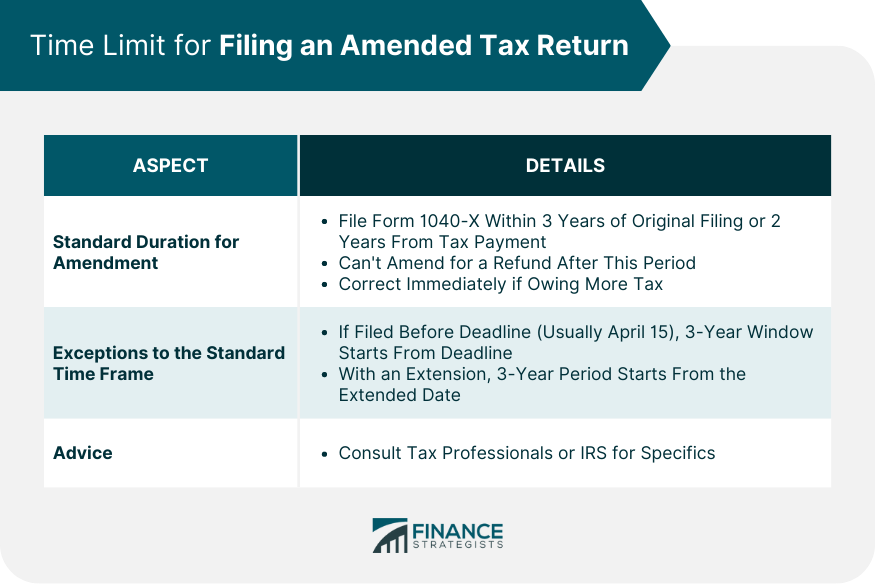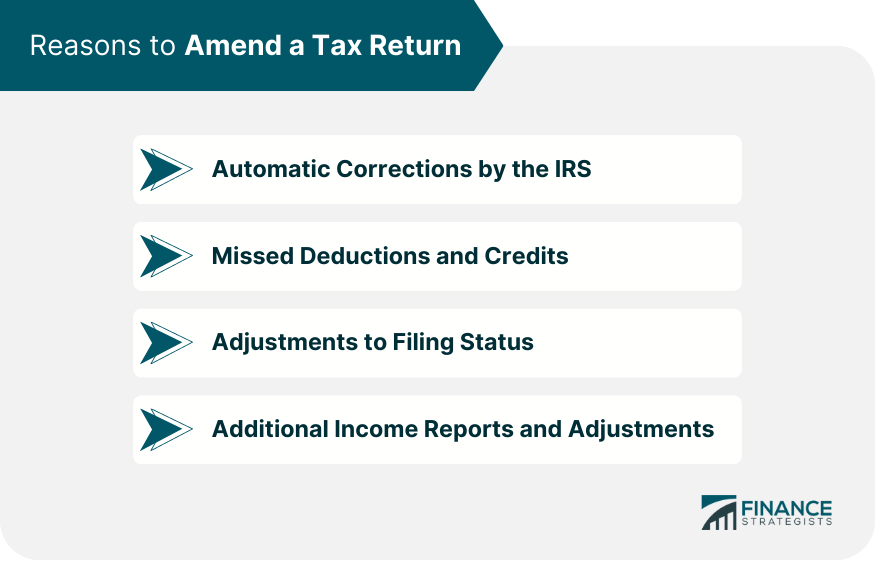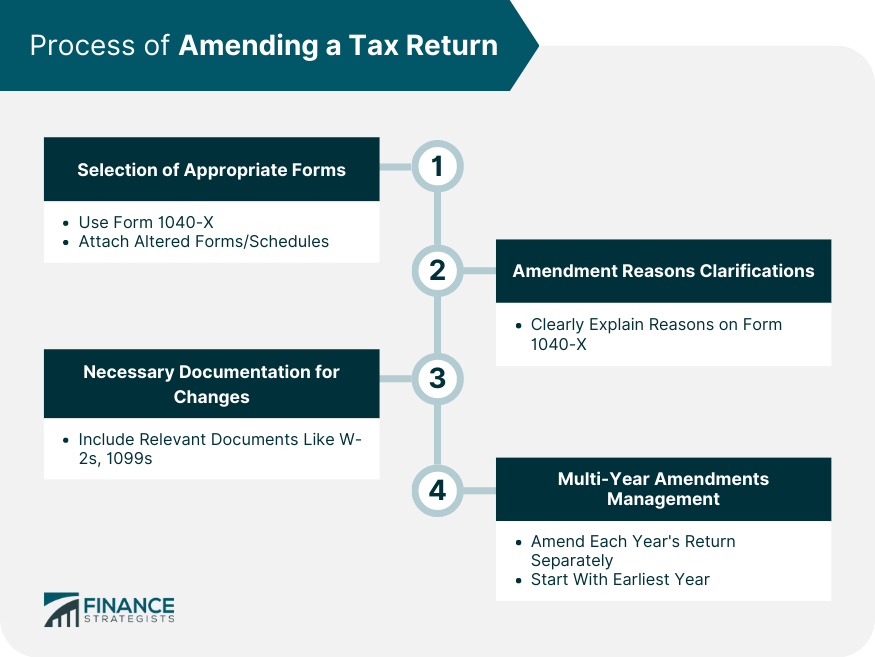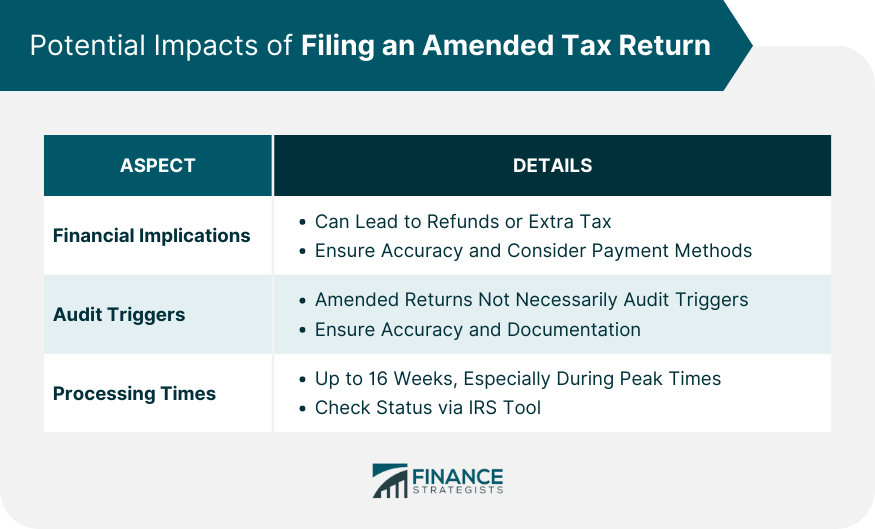Every year, millions of taxpayers file their tax returns. However, mistakes can happen, and sometimes those errors are recognized only after the original return has been filed. An amended tax return becomes essential in these situations. This process allows taxpayers to correct errors, report overlooked income, and claim missed deductions. In essence, it's a do-over, but there are procedures and timelines to follow. Amending your tax return is not as daunting as it may seem. While the idea of reopening a filed document can be intimidating, the Internal Revenue Service (IRS) has a system in place to make the amendment process relatively straightforward. Knowledge is power, and understanding this procedure will ease any apprehensions. The IRS sets specific guidelines on how long you have to amend your tax return. Typically, to claim a refund, you must file Form 1040-X within three years from the date you timely filed your original tax return or within two years from the date you paid the tax, whichever is later. Remember, it's about claiming refunds, not just making corrections. Being aware of these dates is crucial. If you realize you've made an error after this time has passed, you won't be able to amend your return for a refund. However, if the amendment means you owe more tax, it's in your best interest to make the correction as soon as possible to avoid potential penalties and interest. While the three-year rule is generally firm, there are some exceptions. For instance, if you filed your original return before the deadline (typically April 15), the IRS considers it filed on the deadline date. Therefore, your three-year window begins from that date, not the date you actually filed. Another nuance to be aware of: if you were granted an extension for your original tax return, the three-year period starts from the extended due date. Always consult tax professionals or the IRS directly for specifics, especially if you're nearing the end of your amendment window. It's not uncommon for the IRS to correct minor errors on returns. This includes math errors or forgetting to attach a schedule. If they make such corrections, they will send a notice explaining the changes. In such cases, an amended return might not be necessary. However, it's always a good idea to review the changes made by the IRS. While they can correct arithmetic errors, they may not know about other details that could affect your tax return, such as an additional income source they weren't informed about. Taxpayers sometimes overlook valuable deductions or credits when they file. Maybe you forgot to claim the student loan interest deduction or didn't realize you qualified for the Earned Income Tax Credit. If you discover these omissions after you've filed, an amended return can help you claim what you missed. Correcting these oversights can lead to significant refunds. The tax code is complex, and many credits or deductions might be overlooked, especially if you're not using tax software or a professional preparer. It pays to double-check your return before and after filing. Your filing status plays a pivotal role in how your taxes are calculated. Sometimes, after filing, one realizes that a different status—such as "Head of Household" instead of "Single"—would have been more beneficial. An amended return allows you to make this change. Choosing the correct filing status can impact the tax bracket you're in, the standard deduction amount you're eligible for, and more. While this might seem like a minor detail, it can make a substantial difference in your tax liability or refund. Occasionally, taxpayers might forget to report certain income sources. Perhaps you forgot about a side gig early in the year or a small bank interest income. When you remember or receive documentation after filing your return, you should correct this with an amended return. Remember, the IRS receives copies of all your W-2s, 1099s, and other tax forms. If your reported income doesn't match their records, it can raise red flags. Addressing this proactively can prevent complications down the road. The primary form used to amend your tax return is Form 1040-X. This form allows you to make changes to your originally filed Form 1040 and explain why you are making those changes. It's structured to let you show the IRS the original numbers, the changes you're making, and the corrected numbers side by side. Using the correct forms is crucial. While Form 1040-X is the staple for amendments, ensure you also attach any other forms or schedules that change as a result of your amendment. It provides clarity to the IRS about the nature and reason for the changes. When filling out Form 1040-X, there's a section dedicated to explaining the reasons for the amendments. This isn't just a formality. The IRS genuinely wants to understand why changes are being made, so clarity and precision are important. While you don't need to write an essay, being concise and clear can expedite the processing of your amended return. For instance, instead of writing "Forgot some income," you could specify "Did not include income from freelance job in the initial return." Documentation serves as the backbone of the tax world. When you amend your return, ensure you attach any relevant documents, forms, or schedules that support the changes you're making. This might include new W-2s, 1099s, or receipts for deductions. The IRS operates on verifiable information. When you provide ample evidence to justify your changes, it helps the processing of your amended return move smoother. Without supporting documentation, the IRS might delay or question your amendments. There are times when a mistake on one year's tax return carries over to subsequent years. In such scenarios, you'll need to file an amended return for each affected year. And remember, each amended return must be mailed in a separate envelope. Correcting multi-year errors can be a bit of a jigsaw puzzle. You'll want to amend the earliest year first and wait for that to be processed before amending subsequent years. This ensures consistency and accuracy across all affected returns. The digital age has transformed many of the ways we conduct business, and tax filing is no exception. However, there are limitations when it comes to amending returns electronically. As of now, any amended Form 1040 and 1040-SR returns older than three years or Form 1040-NR and 1040-SS/PR returns older than two years can't be amended online. These electronic filing restrictions are in place due to various logistical and data integrity concerns. As technology advances, these limitations might change. However, it's vital to stay updated with the latest IRS guidelines on this matter. While the IRS encourages electronic filing for its efficiency, some scenarios necessitate the old-fashioned paper route. For instance, if amending returns for specific tax years or forms not supported electronically, paper is the way to go. Additionally, if you filed a paper return for a particular year, the amended return for that year must also be paper-filed. The paper process might seem slower, but it's equally effective. Ensure you follow all the guidelines, attach necessary documents, and keep copies for your records. Electronic filing comes with a slew of benefits. It's generally faster, both in terms of sending your information to the IRS and receiving confirmations or refunds. Plus, the e-filing systems often have built-in error checks, decreasing the likelihood of simple mistakes. Additionally, the environmental impact is considerably less with e-filing. No paper forms, no postage, and no fuel for delivery trucks. It's a modern approach that meshes well with a society increasingly geared towards sustainability and efficiency. State tax return amendments are separate from federal amendments. While the federal return deals with national taxes and is submitted to the IRS, each state manages its tax system. If you discover an error on your state return after filing, you'll need to follow your state's specific procedure for amendments. The forms and rules can vary widely from state to state. Some states might have more generous amendment windows, while others could be stricter. It's paramount to be aware of your state's requirements and to address any errors promptly. Just as each state has its tax laws, amendment time frames can differ. While the federal time frame for amendments might be three years, a state might have a different duration. Staying informed about these nuances ensures you remain compliant and can make necessary corrections in a timely manner. State tax websites are excellent resources for understanding amendment procedures and time frames. They often provide detailed instructions, necessary forms, and contact information for further assistance. Amending your return can lead to either a refund or an additional tax liability. If you've paid too much tax, the IRS will send you a refund. On the other hand, if your amendment shows you owe more tax, it's best to pay the amount as soon as possible to limit interest and penalties. Understanding the financial implications is essential. If you're due a refund, consider how you'd like to receive it. If you owe, consider the best payment method. Either way, it's about ensuring accuracy and fairness in your tax responsibilities. A common myth is that amended returns are more likely to trigger an IRS audit. While an amended return undergoes review, it doesn't necessarily mean it's flagged for an audit. The primary concern of the IRS is accuracy, not penalizing honest mistakes. However, it's crucial to ensure your amended return is as accurate as possible. Double-check all numbers, provide clear explanations, and attach necessary documentation. Taking these precautions not only reduces the likelihood of further issues but also ensures you're complying fully with tax laws. Processing times for amended returns can vary, but they usually take longer than original returns. On average, the IRS states it can take up to 16 weeks to process an amended return. During peak tax times, this duration might be longer. Patience is essential. While waiting, you can check the status of your amended return using the IRS's "Where's My Amended Return?" tool. It provides up-to-date information and can ease anxieties during the waiting period. Navigating the complexities of taxes can be daunting, especially when rectifying errors through an amended return. However, the process, overseen by the IRS, ensures that taxpayers have an opportunity to correct mistakes, claim overlooked benefits, or report additional incomes. This system underscores the importance of accuracy in financial dealings, with clear guidelines on amendment time frames and the necessity to act promptly, especially when refunds are at stake. While the digital age has streamlined many aspects of the process, restrictions still require taxpayers to familiarize themselves with both electronic and paper filing methods. Moreover, state tax amendments have their own unique procedures, distinct from federal guidelines. Addressing errors proactively and comprehending the system can mitigate financial implications and the mythicized audit risks. In essence, while amended returns might feel overwhelming, armed with knowledge and diligence, taxpayers can navigate this process confidently and ensure their tax responsibilities are accurate and fair.Overview of the Amended Tax Return Process
Time Limit for Filing an Amended Tax Return
Standard Duration for Amendment
Exceptions to the Standard Time Frame

Reasons to Amend a Tax Return
Automatic Corrections by the IRS
Missed Deductions and Credits
Adjustments to Filing Status
Additional Income Reports and Adjustments

Process of Amending a Tax Return
Selection of Appropriate Forms
Amendment Reasons Clarifications
Necessary Documentation for Changes
Multi-Year Amendments Management

Electronic vs Paper Filing of Amended Returns
Restrictions for Electronic Filing
Scenarios Requiring Paper Filings
Advantages of Digital Filing
State Tax Return Amendments
Distinctions From Federal Amendments
Varied State Time Frames
Potential Impacts of Filing an Amended Tax Return
Financial Implications: Refunds and Debts
Audit Triggers and Precautions
Expected Processing Times

Bottom Line
How Long Can You File an Amended Tax Return? FAQs
Typically, you have three years from the date you filed your original return or two years from when you paid the tax to amend for a refund.
Reasons include overlooked deductions, adjustments to filing status, or unreported income.
While some amended returns can be filed electronically, there are restrictions based on the form's age and type.
Yes, each state has its specific procedure and timeline for amendments separate from the IRS.
While reviewed, amended returns don't necessarily increase audit chances; accuracy is the IRS's primary concern.
True Tamplin is a published author, public speaker, CEO of UpDigital, and founder of Finance Strategists.
True is a Certified Educator in Personal Finance (CEPF®), author of The Handy Financial Ratios Guide, a member of the Society for Advancing Business Editing and Writing, contributes to his financial education site, Finance Strategists, and has spoken to various financial communities such as the CFA Institute, as well as university students like his Alma mater, Biola University, where he received a bachelor of science in business and data analytics.
To learn more about True, visit his personal website or view his author profiles on Amazon, Nasdaq and Forbes.











